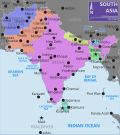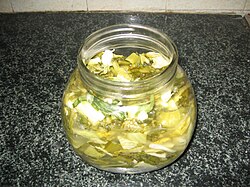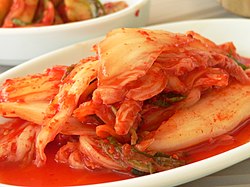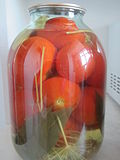Pickling

Pickling is a method of making food last longer. In pickling, the food is put either into vinegar, or in salt water (called brine). This food is often put in an airtight jar. Pickling also changes the flavour of the food.
The key to pickling is that it produces low pH, 4.6 or lower.[1] This kills most bacteria. Pickling can preserve perishable foods for months. Anti-microbial herbs and spices, such as mustard seed, garlic, cinnamon or cloves, are often added.[2]
Common pickled foods include eggs, onions and other vegetables.
Pickling Media
A jar of pickled cucumbers (front) and a jar of pickled onions (back)
Dưa cải muối made from cải bẹ xanh
Kimchi is a very common side dish in Korea.
Torshi, traditional pickles in Southeast Europe, Turkey and the South Caucasus
Coriander seeds are one of the spices popularly added to pickled vegetables in Europe.
Jonjoli Georgian pickled flowers of bladdernut
Pickled tomatoes are common in the post-Soviet states.
References
- ↑ Minnesota Department of Agriculture "Pickle Bill" Fact Sheet, www.mda.state.mn.us
- ↑ Antimicrobial Effects of Mustard Flour and Acetic Acid, www.ncbi.nlm.nih.gov
Other websites
![]() Media related to Pickled food at Wikimedia Commons
Media related to Pickled food at Wikimedia Commons











